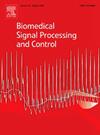利用共振耦合传感器估算心室尺寸对旋转血泵进行生理控制
IF 4.9
2区 医学
Q1 ENGINEERING, BIOMEDICAL
引用次数: 0
摘要
旋转血泵(RBP)目前以固定的泵速运行,不能满足生理需求,易受心室吸引的影响。为了克服这一限制,我们开发了一种基于左心室舒张末期容积(EDV)的生理控制算法,该算法使用谐振耦合的高效传感器。共振耦合传感器由尖端和流出传感器组成,可以在9个月时以最小的长期漂移(~ 1%)准确评估心室大小。控制算法的能力是通过一个与轴向或离心流RBP耦合的硅循环系统模型来评估的,该模型具有15%均匀分布的测量噪声。将EDV设定值设置为85 ml,评估EDV控制算法的有效性,并与在(1)休息和运动期间保持恒定泵速进行比较;(2)肺血管阻力快速8倍增强;(3)休息和运动之间的快速转换。通过假设6%的体积漂移,还评估了算法的安全性和鲁棒性。EDV控制算法在所有病例中均提供充分的生理灌注,避免了心室吸痰。对于两种类型的RBP, EDV算法的性能优于保持恒定的泵速,证明了所提出算法的泵独立性。本文章由计算机程序翻译,如有差异,请以英文原文为准。
Physiologic control of rotary blood pumps by ventricular chamber size estimation using resonantly coupled sensors
Rotary blood pumps (RBP) currently operate at a fixed pump speed and are unable to meet physiologic demand and susceptible to ventricular suction. To overcome this limitation, we developed a left ventricular end-diastolic volume (EDV) based physiologic control algorithm using resonantly coupled high-efficiency sensors. The resonantly coupled sensors consist of apical and outflow sensors that can accurately assess the ventricular chamber size with minimal long-term drift (∼1 %) at 9 months. The ability of the control algorithm was evaluated using an in-silico circulatory system model coupled to an axial or centrifugal flow RBP with 15 % uniformly distributed measurement noise. The EDV setpoint was set to 85 ml, and the efficacy of the EDV control algorithm was evaluated and compared to maintaining a constant pump speed during (1) rest and exercise; (2) rapid, eight-fold augmentation of pulmonary vascular resistance; and (3) rapid transitions between rest and exercise. Safety and robustness of the algorithm was also evaluated by assuming a 6 % volume drift. The EDV control algorithm provided sufficient physiological perfusion and avoided ventricular suction in all cases. Performance of the EDV algorithm was superior compared to maintaining constant pump speed for both types of RBP, demonstrating pump independence of the proposed algorithm.
求助全文
通过发布文献求助,成功后即可免费获取论文全文。
去求助
来源期刊

Biomedical Signal Processing and Control
工程技术-工程:生物医学
CiteScore
9.80
自引率
13.70%
发文量
822
审稿时长
4 months
期刊介绍:
Biomedical Signal Processing and Control aims to provide a cross-disciplinary international forum for the interchange of information on research in the measurement and analysis of signals and images in clinical medicine and the biological sciences. Emphasis is placed on contributions dealing with the practical, applications-led research on the use of methods and devices in clinical diagnosis, patient monitoring and management.
Biomedical Signal Processing and Control reflects the main areas in which these methods are being used and developed at the interface of both engineering and clinical science. The scope of the journal is defined to include relevant review papers, technical notes, short communications and letters. Tutorial papers and special issues will also be published.
 求助内容:
求助内容: 应助结果提醒方式:
应助结果提醒方式:


